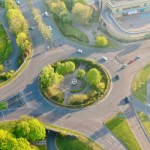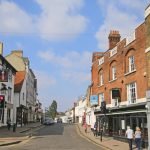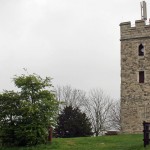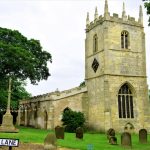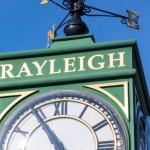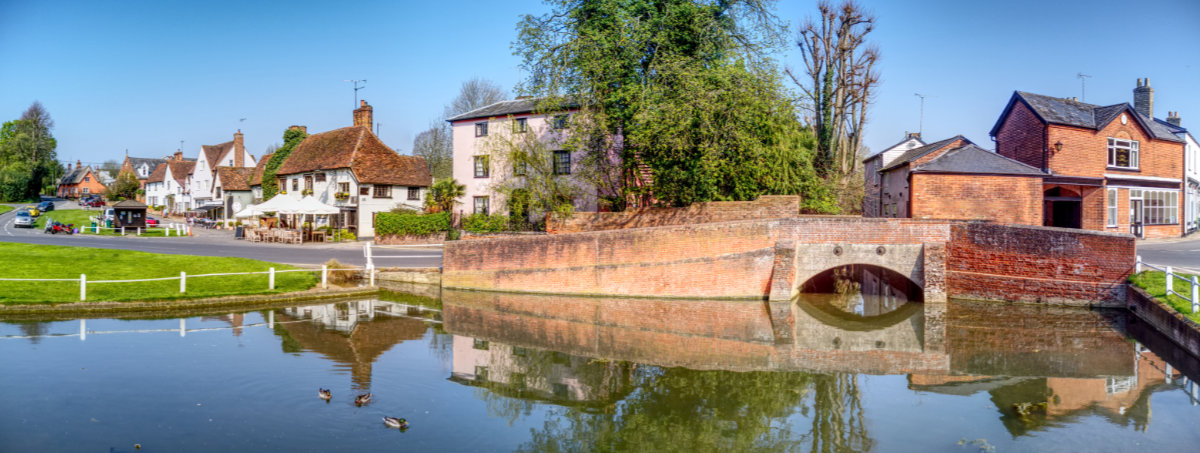
Braintree may not be one of the first places you would think of when someone says name a town in Essex, however, it is one worthy of your attention if you are in the area. It is set in some of the counties most idyllic countryside on the River Brain and surrounded by some of Englands most picturesque villages. Braintree may not be big, by Essex standards anyway, but it seems to have pretty much everything you could ask for in a staycation or day trip location.
If shopping is your thing then you will love the outlet shopping village which features stores belonging to the worlds most prestigious brands. Mora a history buff, well they have that covered too with an abundance of museums and listed buildings to explore.
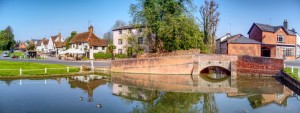
A Stunning view from the nearby Village of Finchingfield. Image: JMAV/Shutterstock.com
More of an out and about type of person? Well, the countryside is beautiful and as we have mentioned there are a number of chocolate-box pretty villages to explore. Plus there is fishing and Birdwatching opportunities too. They even have a local football team who came really close to being promoted into the football league too!
Anyway if this has piqued your interest read on and learn a little more about what this lovely place has to offer. Starting as per usual with a little bit of history.
Early History of Braintree
Braintree takes its name from being a settlement on the River Brain. It appears the ‘tree’ part has changed multiple times through the early years, though. Since the town has been in existence since the Stone and Bronze Ages, it seems only right that the name for it might have changed a bit, back and forth. It’s been called Brantry, Branchetreu, Branktry, and – earliest of all – Branoc’s Tree.
During the Iron Age, the area was settled around the river. Those that lived there named it the Brain Valley. Iron and Bronze Age homes have been found there.
Later, around the turn of the 1st century, the Romans arrived here. They liked to build near rivers and created two main roads through the town and the settlement expanded around the crossroads. It is thought that the area would have been largely abandoned after the Romans returned to Italy, although some soldiers would have had families and chosen to stay behind. Evidence that has been dug up in the area shows that the settlement was extensive.
A dig conducted in 1974 found that the area was occupied in the 1st and 2nd centuries, likely diminishing by the 3rd and 4th. The dig took place at Stane Street, one of the aforementioned Roman Roads that has kept its name since the Romans gave it.
When the Romans left, the Saxons took over. The River Brain is a blackwater River but would have provided food and powered the early mills.
Doomsday Braintree
The final notes on Braintree during those early times comes from the Domesday Book. This book was created in 1086 and was an ordnance survey issued by King William the Conqueror who wanted to see what he had acquired. It is thought to have been the first of its kind in Britain. The land around Braintree is said to have belonged to two owners with no recorded population. There are two possible reasons why the population was not mentioned. The first, that the town was largely abandoned. The second, that the town had such a big population that it wasn’t counted.
The two owners in the town were Leodmer of Hempstead and Richard, son of Count Gilbert. Gilbert made three shillings from the land annually. Leodmer also made three shillings annually off this land. What is not recorded, are animals, people, or meadows. The record is paltry by comparison to other entries in the survey. However, it does show us that the land was still in use. You can view the entry for yourself here.
The town must have been of a reasonable size after the Doomsday survey was completed. The evidence we have for this is that the Bishop of London obtained a market charter for the town in 1190. A market charter would have allowed them to hold weekly trades. It would also have allowed an annual fair. Commerce in those early days came mostly from the pilgrims that used the town as a stopover point. There would have been inns for them to sleep in, plenty of food and drink supplies to stock up on, and even a stable for the horses.
Mediaeval Braintree
During mediaeval times, Braintree was famous for its output of cloth. This mostly came from Flemish traders who settled here circa the 14th century. A weekly market has been held here on a Wednesday ever since the mediaeval era. The market trades in corn, cattle, provisions, and of course, wool. Although the wool trade dried up before the Industrial Era, it was quickly replaced by the silk trade, which continued right up until the 20th century.
The star attraction of Medieval Braintree is the nearby Cressing Temple. It is this ancient monument that would have seen a constant stream of pilgrims pass through the town of Braintree. It is between Witham and Braintree and is said to have been one of the earliest and biggest halls of the Knights Templar in Britain. It is still in existence today, having been lovingly restored for all to use.
The monument would have been built all the way back just after the manor and estate was gifted to society in 1136. Sometime before the Bishop of London granted the town a charter. This site is of such significance that it was the first listed Templar estate in the detailed records made in 1085 of their holdings.
The Plague
Let’s take a moment to remember the great plague of 1665. This plague killed 865 out of the estimated population of 2300 people. This is the same plague that was named the Great Plague of London. During it, King Charles the Second of England, his family, and his entire court, all fled the capital city. It was the worst plague since the Black Death of the 14th century. By the time it was over, estimates suggest it killed 100,000 people.
That’s one-quarter of the population of London at the time. It did this over a period of 18 months. In modern times, this is a story that is too familiar. Obviously, this plague was not limited to London and smaller towns like Braintree were also affected.
The next notable events from Braintree didn’t happen until the Industrial Era a couple of hundred years later. Let’s take a historical break for the moment and turn to the fun facts and trivia about Braintree, instead.
A Bit Of Braintree Trivia
If you are visiting, staying with friends, or moving into the area, you need some local knowledge to dazzle your friends with. Here are some things you can bring up in conversation to make you seem like one of the locals:
- Cressing Temple, mentioned above, is one of the oldest surviving timber-framed buildings in the entire British Isles. It was completed in roughly 1206. You can get married there.[i]
- The wool made in Braintree was exported to places like Spain and Portugal.
- The tribe that settled the area of Braintree during the Iron Age were known as the Trinovantes. They are thought to have died out in the mid 50 BCs.
- Braintree Railway was laid in 1848 and cost the builders £40,000 per mile. That was the last time you could get a train ticket for under a tenner.
- The Corn Exchange cost £3,000 to build in the same era. The townsfolk sold £25 shares to raise the capital.
- Pilgrims passed through to the shrines of St Edmund and our Lady of Walshingham from the south.
- A large number of Roman coins was found here in 1828 by a gardener. His find was accentuated by an urn of coins minted to Emperor Vespasian and later, a medal of Antonius was found, too.
If you live in Braintree, it’s probably time to buy a shovel and a metal detector. It seems like there was a lot of Roman activity in the area, particularly around Stane road.
Anyway, that’s all just speculation and you shouldn’t dig up any gardens. Let’s return to the history for the second half.
Industrial Era Braintree
An independent chapel was erected in Braintree in 1707. During this time White’s Directory recorded the town as having 7,000 inhabitants. They note that the 14 mile railway was completed in 1848 and that Braintree Parish at that time consists of 2242 acres of land. Bocking Parish nearby had a population about half this size.
In the 1840s, the wool trade was still in operation, but it would later die out and be replaced with silk. The Corn Exchange was finally constructed in 1839 and two annual fairs were held each year, one in May and one in October. The town had a large gasworks, a workhouse that the poor lived in, and had its own police station. The White Hart was the main inn in town.
We know from this account that there were three incendiary fires in 1844 which did significant damage. In March that year, 19 cottages were burned down on Coggeshall Road. The town was notoriously filled with dissenters from the church. If you are descended from old Braintree stock, your ancestors probably protested the church’s grip on the land before Henry VIII had his way.
The 19th century saw the town become a large silk manufacturer, which didn’t end until the 20th century. There were silk mills all over, with plenty of local agriculture meaning a good leather and cattle trade. When the town was finally connected to London, it expanded greatly, right on up until the late 1800s, when amenities like public gardens were finally added.
Modern Braintree
The modern era saws the slow death of the silk manufacturing plants. Men signed up in the masses to fight for Braintree in WWI. The first local lad to die in the war was a Bocking man named Lance Corporal Frank Herbert Rankin. He was only 25. The Braintree Museum records one of the last to die as Private William Arthur Ratcliff, from Panfield Lane. He had worked in the mills spinning silk before being killed on the 8th of November, just three days shy of the end of the war.
During WWII the locals and the fighting men played a vital part in the war effort. A nearby factory was converted towards making munitions and manned by local women. If any German bombers had bombs left over when they were flying back from London, Braintree took the hit. The White Hart Inn escaped bombing by one street, with two buildings across the road being demolished in a bombing raid. Braintree also harboured evacuee children from the cities, you can read an account here.
Modern Braintree no longer relies on the silk trade for income but has its roots in industry and retail. The addition of a designer outlet on top of two retail centres with more than a hundred stores, means the majority of those living and working in town are in retail. The area is well connected to transport links and has plenty of sights to see and things to do… which we will get to directly.
This is a town with a serious 4,000 year + history and a lot to be proud of. It is a Great British town which should be celebrated. Do your part to boost local economies and go pay it a visit.
Famous People from Braintree
So, if you were to go and spend a few days in Braintree, who are the famous people you might run into in the high street? Here are the Five MinutesSpare favourites:
- Artist Edward Bawden is from Braintree and has gained international acclaim for his work.
- Keith Flint from the Prodigy was born in Braintree, as is Liam Howlett.
- Pro darts player Barry Lynn is a Braintree man.
- Essex cricketers Darren Robinson and Geoff Smith are from here.
- Famous dancer Louie Spence is from here, too.
That’s a lot of people you either do or don’t know. Now that we have this section out of the way, we are free to move on to the part you have all been waiting for: the attractions you might find in Braintree.
Attractions in Braintree
Now that we know everything else about Braintree, let’s talk about the best things to see and do if you are in town.
Historic Sights and Landmarks
You cannot come to this area of Essex and not take a peek inside the Cressing Temple Barns site. This place was built back in the dark ages and has existed ever since, part of the Knights Templar estates in the UK. It is said to have been the largest here, and one of their earliest. It is a mostly wooden and thatch structure that has been restored several times over the years. It also has a restored Tudor Garden and a tearoom on site.
The White Hart Inn is now the White Hart Hotel and we thoroughly recommend that you go for a visit, stay, or meal. This isn’t an attraction, per say, but it is a local landmark. It has been mentioned in the history of the town since the town’s history began and is decorated in the Germanic white and black style.
Galleries and Museums
The Braintree District Museum really is the heart of the community here. It is this place that has kept such detailed historical records of the area which allow us to piece together what happened down through the ages. Here you will find all the Roman items that have shown up here over the years. It has its own gallery incorporated so you can look at local artworks and comes with a gift shop so you can pick out some mementoes.
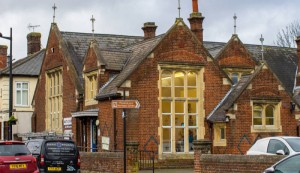
Braintree District Museum Image: By Aimur Kytt/Shutterstock.com
Those interested in the artistry of textile making would do well to investigate the history of this subject within the area. To do that, head to the Warner Textile Archive, which has a detailed history of the textiles created in Braintree down through the ages. This specialist museum is frequented by students studying art history and textile design. It’s a good backup for your knowledge base as a designer, too.
Those interested in seeing how the medieval residents of Braintree lived can head to the Great Bardfield Cottage Museum, just out of town. This preserved cottage is run by Historic England and is a Grade II listed building. It was erected in the late 16th century or early 17th century. It’s a fascinating piece of preserved English history.
Outdoor Attractions
Locals love to take a stroll in the Braintree and Bocking Public Gardens. Run by the local council, this place has some lovely areas for peace and reflection. It’s frequented by dog walkers and old ladies alike, so be prepared for it to get busy in summer. The flower beds are worth it. They must share it with Bocking because of its location. They sometimes have markets and events here.
If you happen to love a bit of fishing, there is a great fishery in the area. Fennes fisheries have good rates and a substantial following. It is a Carp Lake, so come equipped with things carp like, like sweetcorn and… erm… worms.
Looking for long walks in the open moors? Then you need Great Notley Country Park. Run by Explore Essex, this area of natural beauty is as outstanding as it gets. You can visit for free and take advantage of being close to nature for an afternoon. Pick a day with good weather because it can get bleak out there, especially in winter. It is home to Sky Ropes, an overhead adventure experience with added adventure playground.
Sports and Recreation
The local football team is Braintree Town FC, who can be found at The Cressing Road Stadium. They have been around since the late 19th century and although they have not got a bulging trophy cabinet, they came mighty close to gaining a place in the Football League as recently as 2015-16.
They currently play (2021-22) in the National League South and the ground holds a bit over 4,000 so getting in to see a game shouldn’t be an issue. Unless they are playing in the FA Cup of course. If you do fancy taking in a game check out our Braintree Town FC page for more info.
If golf is more your sport, you will find the Braintree Golf Club to the north end of the parish. They have a pro shop for all your golfing needs. In addition, those that aren’t very good and want to brush up their game should head to the Richard Wheeler Golf Academy.
Shopping and Retail
You can’t come to town without noticing that there are two distinct areas to it. There is the Braintree Village shopping mall, and then there is everything else. This place is massive, with more than a hundred stores and factory outlets where you can buy cheap designer clothing. Shopping is one of the main reasons that people come to Braintree.
Let’s not forget the second most popular market in Braintree, and that’s the street market held every Wednesday. You will find it outside Sainsbury’s and filled with things like street food, clothing, and vegetables.
Other Notable Attractions
We couldn’t possibly fit all the exciting Braintree attractions into one article without squeezing them up a bit. Here are some other things you might enjoy seeing and doing in Braintree if you have the time:
- Braintree town hall is a good place to take some pics for the gram.
- Visit the Braintree Cage, which was used as an overnight cell by the cops up until 1875. It’s just a brick building with no windows and a single door, but it’s an important part of industrial history in the town.
- Stop by Between the Lines book and coffee shop for a chat.
- There’s a local Partyman World of Play for the kids.
- See Blackwater Alpacas and Pygmy Goats for a great afternoon out.
There are all sorts to see and do here and fun to be had for all ages. Do visit and spend generously, the economy needs it.
How To Get to Braintree
We can’t let you rush off without telling you where you are going. These loose directions might get you lost, but it’s better than nothing.
By Road
Take the A120 west out of Colchester.
By Rail
Braintree Train Station is on the Greater Anglia line.
By Air
London Stansted is the nearest airport.
By Sea
If you can sail the River Brain you can get there, but probably not.
Five Minutes Spare
We have all manner of interesting reads over on our website. Check out our travel pages or learn about a new hobby. The choice is yours and we are here for it. See you soon!
[i] https://information-britain.co.uk/didyouknow.php?town=Braintree&county=26
